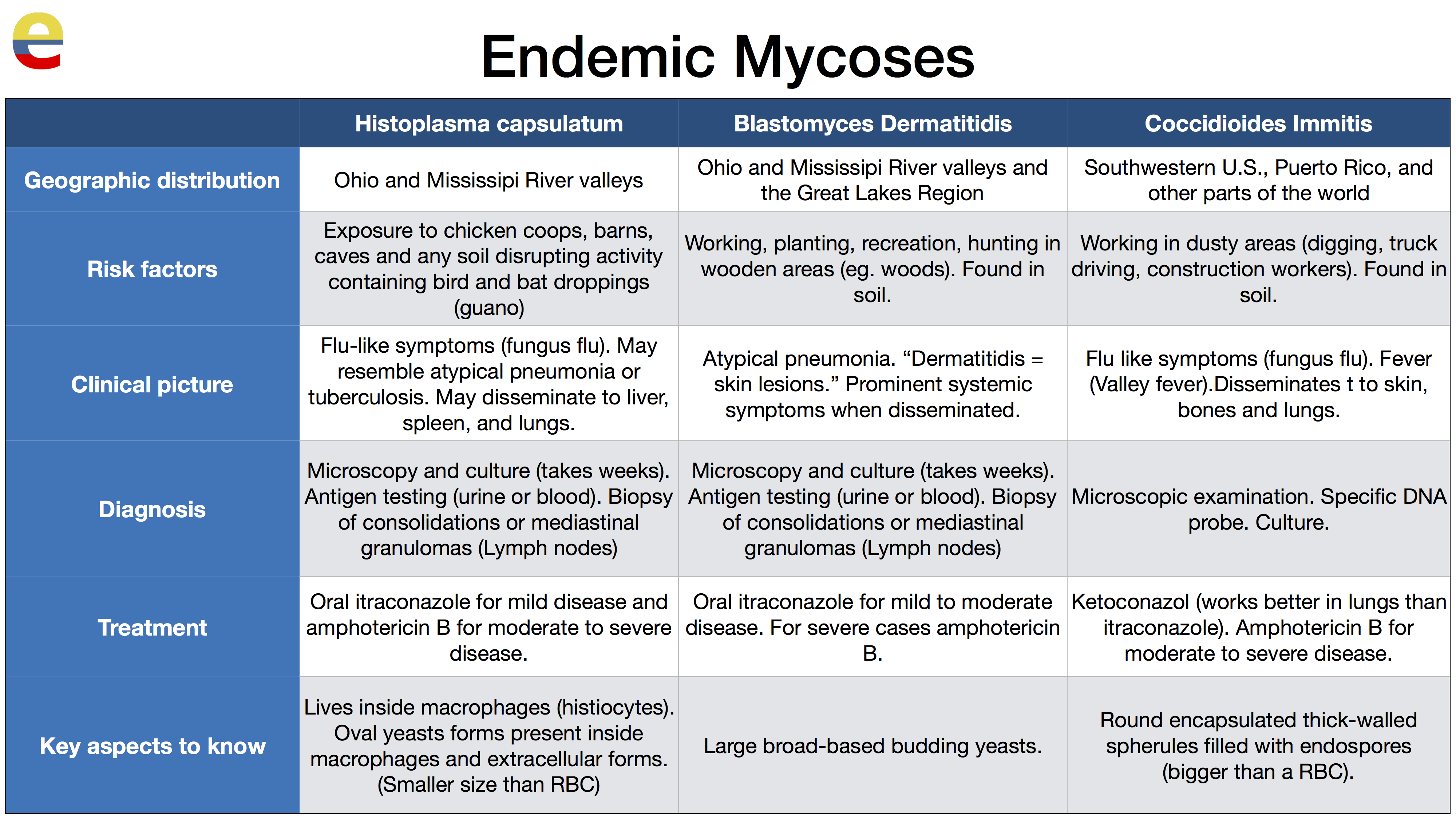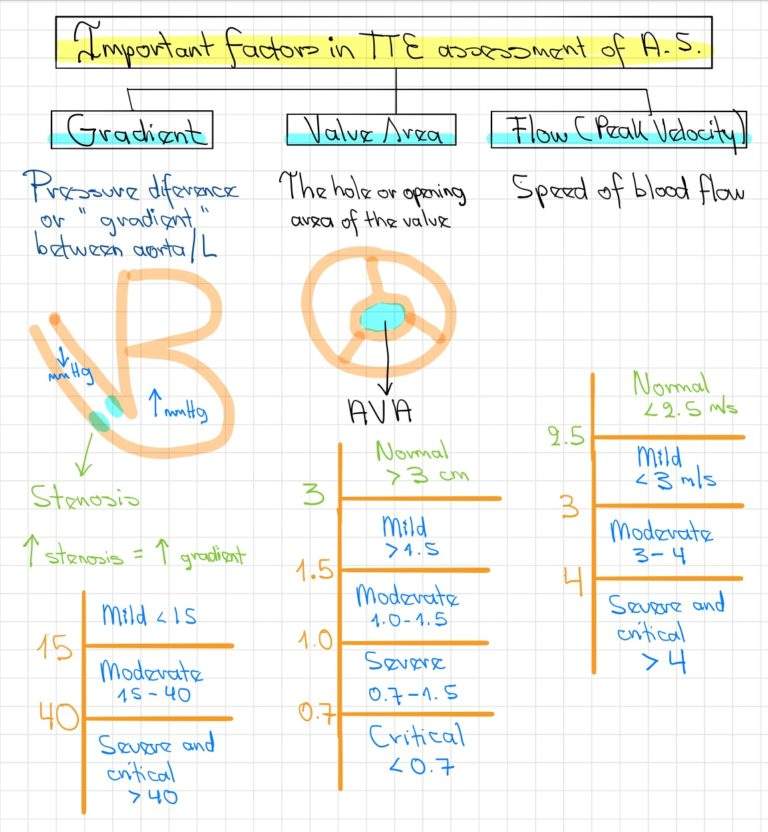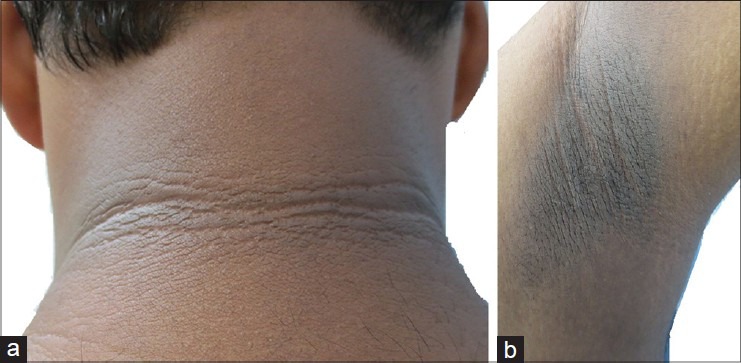The endemic mycoses (dimorphic fungi) are important causes of lung and systemic infections that are somewhat neglected in the medical practice with deleterious results (1). The most important endemic mycoses that affect the respiratory tract are Histoplasma capsulatum, Blastomyces dermatitidis, and Coccidioides immitis. They can present as atypical pneumonia or upper respiratory infections, and as severe systemic infections with high mortalities when treatment is not given.
The major differences between these fungi infections are depicted in the table. One of the most important aspects when considering that a patient may possibly be suffering from one of these infections is the relationship with the geographic area of exposure to these mycoses.
GEOGRAPHIC DISTRIBUTION OF THE ENDEMIC MYCOSES
Which mycoses are distributed in the following blue-colored geographic area?
As one can observe, the geographic distribution of Histoplasmosis and Blastomycosis is very similar. For examination purposes, we cannot use only the geographic area to differentiate between the two pathogens. Therefore, other aspects such as the risk factor exposure, clinical presentation, and laboratory testing can help us to make such discrimination.
GEOGRAPHIC DISTRIBUTION OF COCCIDIOMYCOSIS
Coccidiomycosis is distributed in the Southwestern region of the United States, Puerto Rico and other Central and South American countries, as well as other parts of the world. It is considered a tropical disease which may explain why its distribution predominates in the southern part of the United States.
RISK FACTORS FOR THE ENDEMIC MYCOSIS
1. Histoplasmosis: Exposure to chicken coops, barns, caves and any soil disrupting activity (eg. earthquakes) containing bird and bat droppings (guano commonly found in caves when exploring or spelunking).
2. Blastomycosis: Working, planting, doing recreational activities, or hunting in wooded areas (eg. woods). Found in the soil.
3. Coccidiomycosis: Working in dusty areas (eg. digging, truck driving, construction working). Found in the soil.
As one can observe, the three endemic mycoses are present in the soil. However, there are different activities or risk factors associated with every disease and thus remark a difference in presentation that one should look to make the differential diagnosis.
CLINICAL PRESENTATION
The clinical presentation of the endemic mycoses is quite similar, although they also have unique characteristics. However, it is difficult to distinguish them by clinical picture only. The analysis of risk factors, clinical picture, and laboratory workup should be considered for making an accurate diagnosis.
The most important clinical characteristics that can be seen in all endemic mycoses are:
- Cough, usually nonproductive (dry cough).
- Fever (fungus flu).
- Pleuritic chest pain.
- Progressive shortness of breath.
-
Rheumatologic syndromes (common among endemic mycoses) – Arthritis and arthralgia, erythema nodosum, erythema multiforme, and pericarditis.
-
Airway obstructive symptoms secondary to enlarged mediastinal adenopathy.
- Endemic mycoses with associated dissemination.
- Hypersensitivity or allergic reactions
- Extrapulmonary sites in individuals who are immunocompromised.
One important characteristic of Blastomycosis is the skin involvement in forms of ulcerations, plaques, and verrucae.
DIAGNOSIS:
The diagnostic approach for the endemic mycosis is similar. The most important things to keep in mind is the time of presentation. For acute cases, the cultures (which usually takes weeks) may not be the best option although they should still be done. The antigen testing (especially urinary) or biopsy are the best options.
Important features that are seen in tissue analysis of the endemic mycoses:
ENDEMIC MYCOSIS MANAGEMENT:
Regarding the management, one should consider that most infections are mild and self-limited. Therefore, one approach could be the symptomatic management with supervision of the progression of the disease and adding medications if such conditions do not improve. The management for the endemic mycoses is similar for all of them. Please, click on every disease to get the treatment options.
Side effects of Amphotericin B:
Amphotericin B is a toxic medication and its use should be reserved for moderately severe to severe infections, usually those resulting from disseminated or chronic cavitary disease. Amphotericin can provoke nephrotoxicity, resulting in tubular injury, renal tubular acidosis, hypokalemia, hypomagnesemia, febrile infusion reactions, anaphylaxis, and hepatotoxicity. This explains why it is not used as a first line in patients without a severe form of the disease due to this toxic profile.
References:
- Neglected endemic mycoses. Queiroz-Telles F., Fahal A.H., Falci D.R., Caceres D.H., Chiller T., Pasqualotto A.C. (2017) The Lancet Infectious Diseases, 17 (11), pp. e367-e377. [The Lancet]
- Kauffman CA. Endemic mycoses: blastomycosis, histoplasmosis, and sporotrichosis. Infect Dis Clin North Am. 2006 Sep;20(3):645-62, vii. [PUBMED].
- Histoplasmosis. [Medscape].
- Coccidiomycosis and Valley Fever [Medscape].
- Blastomycosis. [Medscape].
- Aortic Stenosis Severity Classification - 09/22/2020
- Carboplatin (Paraplatin) - 04/07/2019
- How to test for Vitamin D deficiency? - 09/29/2018







This was extremely helpful and concise. Thanks!
Thank you so much SM. So glad you find it helpful!